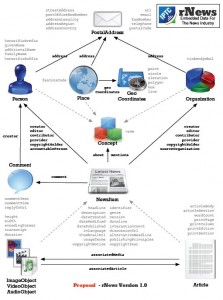Learn more
- Oct 7, 2011
rNews and its benefits for publishers
Last Wednesday at the Open House event of the Semantic Web Company in Vienna, Evan Sandhaus, Lead Semantic Architect at NY Times gave a comprehensive and entertaining introduction to rNews and its potential benefits for publishers.
 Evan Sandhaus (f.l.t.r) busy preparing his talk in the kitchen of SWC, together with Andreas Blumauer (SWC) and Leo Sauermann (Gnowsis). Evan Sandhaus (f.l.t.r) busy preparing his talk in the kitchen of SWC, together with Andreas Blumauer (SWC) and Leo Sauermann (Gnowsis). |
 Mr. Sandhaus in action. Mr. Sandhaus in action. |
rNews is a RDFa vocabulary, which is basically a carefully selected subset of the very rich IPTC vocabulary and some additional elements that came up during the standardization process. It is now available in version 1.0 and – according to Evan – actively supported by schema.org.

Evan mentioned three scenarios that might drive the uptake of rNews for the benefit of news publishers:
1) Better news search
rNews allows you to explicate and differentiate various documents elements like, title, author, text body, picture etc., thus giving the publisher better control of what to expose for indexers and web crawlers. This might not just improve the display of rich snippets in the search results of Google and other search engines, but also allow automated population of faceted search and metadata based similarity search.
2) Better ad placement
As rNews can be applied to any kind of news-relevant media irrespective of its format (grafics, audio, video, etc.) the metadata can be used to avoid “unfortunate juxtapositions” between editorial content and ads. Hence, media agencies could profit from this additional data by fuelling their matching algorithms and gain better insight into the context specificities of content items.
3) Better analytics
By improving the semantic granularity of a news item this additional information can be used to carry the web analytics beyond the page level and provide a better insight into usage patterns. The additional data can be applied for visualization and exploration purposes i.e. for search engine optimization, sentiment detection and many more.
This is just a small fraction of things rNews could be used for. All in all it is exciting to see that IPTC has finally started to provide publishers with a standard that is relatively easy to implement and help them to overcome the obstacles of existing technologies without disrupting existing publishing workflows. In multi-sided markets like the news industry this might be a crucial success factor!
